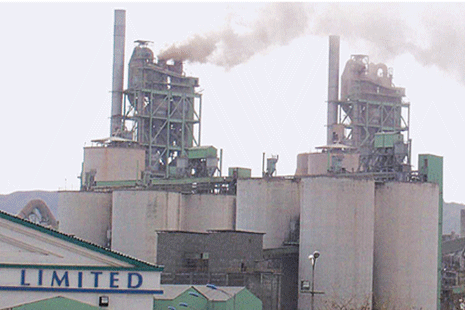Cement Factories: Environmental Damage to ‘Kahoon Valley’ The Salt Range
A decade ago, visits to our very historical ancestral village of Dulmial, Kahoon Valley in the Salt Range, were always filled with excitement to spend quality time in a serene clean environment that was very close to nature. A place where we would be astonished to see thousands of stars while lying under the crystal clear sky at night. An area where we would hear beautiful birds singing during the dawn and hospitable people gathered for communal discussions in the centre of the village during dusk.
However in recent years, the beautiful valley of Kahoon, which has been home to many generations, together with tourists attracted to the nearby ‘The Katas Raj’, has been severely affected by environmental impacts due to the construction of cement factories in the locality. The high rising infrastructure of the factories, in the middle of a scenic serene valley has stolen away the beauty of the land and painted a ruthless picture of unplanned development.

The construction of the factories had allegedly been undertaken without consultations with the local stakeholders and communities which is essential under the law. According to the Policy and Legal frameworks applicable to the project, an Environment Impact Assessment study must be undertaken under the Section 12(1) of Pakistan Environmental Protection Act, 1997 (Amended 2012).
The practical situation reveals a worrying story. The operation is now a major nuisance and hazard for the local people, flora and fauna.
The project is a true image of unsustainable development due to its reckless extraction of limestone from the adjacent mountains which has resulted in severe impacts on the soil, water and air quality of the area, thus burdening the valley with its everlasting turmoil.
The cement industry is one of the 17 most polluting industries listed by the central pollution control board. The air emissions are a source of Particulate Matter, sulphur dioxide, nitrous oxide, carbon dioxide and the dust particles that contain heavy metals which are hazardous to the biotic environment with impacts on vegetation, human and animal health and the ecosystem.
Prolonged exposure can cause serious irreversible damage to plants and animals. The cement dust of sufficient quantities have been reported to dissolve leaf tissues. Other reported effects of cement dust on plants include reduced growth, reduced chlorophyll, clogged stomata in leaves, cell metabolism disruption, interrupt absorption of light and diffusion of gases lowering starch formation and reducing fruit setting. Cement industry pollution is reported to be majorly impacting wheat plants shoot length, root length, number of branches, leaves and flowers, number and weight of seeds.
Thus if the current scenario prevails, the existence of these factories will severely affect the wheat production of the local area which is one of the major sources of food and income for the local farmers. In the future, a combination of reduced rainfall due to changing weather patterns in the area and increasing air pollution could have serious food security and economic instability issues in the area.

Cement dust is known to cause respiratory, haematological diseases, cancers, eye defects and genetic problems. Besides gaseous and particulate pollutants there are enhanced levels of toxic heavy metals in the environment of cement factory such as cobalt, lead, chromium, nickel and mercury which pose serious health implications. From personal accounts a rise of cement dust related health issues has occurred. However this is an area which should be researched further.
It is important to discuss here that inhabitants of the Kahoon Valley are also livestock keepers that offers them an opportunity to combat poverty. Livestock is used to carry heavy loads, help plough fields and provide means for transportation. Their manure fertilizes the soil and income from their products (milk, eggs, meat) allow the poor families to put food on the table and improve their nutrition. Thus, diseases affecting livestock can have devastating impact on animal productivity, production and consequently on the overall process of area’s economic development.
The deposition of cement dust leads to alkalization of the ecosystem and thus changing the composition of the soil that can adversely affect plant survival and growth. This can have long term impacts on the productivity of the area and this decreased production of food crops leading to increased burden onto the poor communities.
All of these accumulative impacts are a great concern of the inhabitants of Kahoon Valley. Therefore, it is urged to the relevant environmental departments and higher authorities of the cement factories that considerable measures must be taken on time to prevent the detrimental impacts. For the sustainable development it is recommended to focus on the effective emission control technology, energy efficiency, adoption of state of art technology and global synergy in environment friendly technologies. If we want to prosper as a nation it is essential to consider benefits for the people and country at large, and ignore individual interests. Economic, social, health and environmental sectors must be given the required significance.
Historical places such as Kahoon Valley must not be subjected to environmental impacts or be made a dumping land for the cement industries. Instead, its history of being considered as a beautiful scenic valley, as acclaimed by many visitors must be projected for tourism. Biodiversity must be protected and the very hospitable inhabitants must be ‘at least’ provided with the basic right of life such as clean air to breathe and clean water to drink!
Instead of driving vulnerable communities of the country towards extreme poverty, poorer health and consequent implications, it’s essential to empower them in their local income sources so that they can add their share to make Pakistan a prominent developing nation on the world map.
Note: This article was written with the kind assistance of Wajeeha Malik, Young Development Fellow, Ministry of Planning, Development and Reform. Government of Pakistan. MSc. Sustainability (Environment & Development) University of Leeds, UK. Commonwealth Sponsorship 2012/13.

